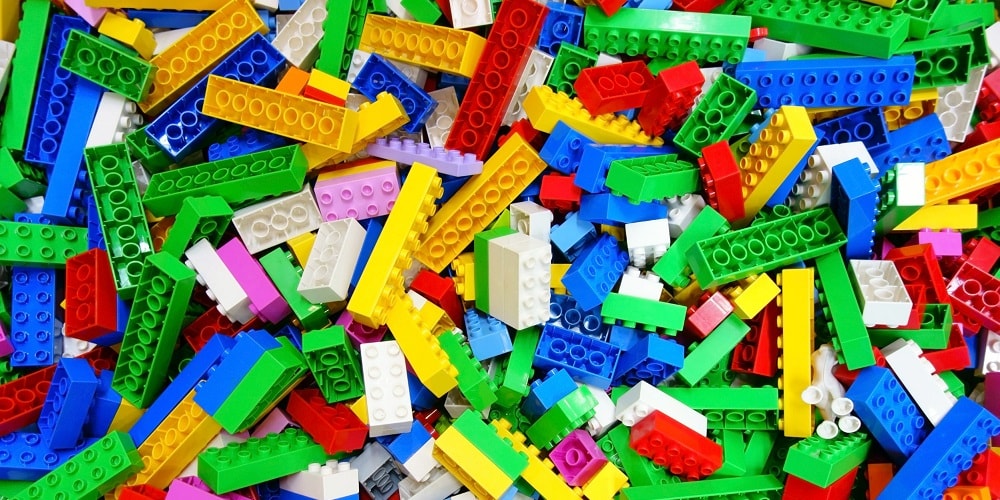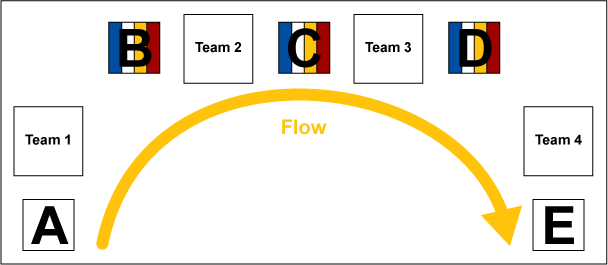
Key Points
- The Lean Lego Game gradually introduces participants to Lean principles in an easy-to-understand way.
- The game comes in two separate durations, one with a shorter running time for those on a tight schedule.
- Showing the different processes that go into making a uniform Lego house introduces users to a plethora of concepts seen through Lean Six Sigma.
After revolutionizing the automobile industry, Lean principles are in use across several industries. However, many people don’t know the concepts that make Lean successful.
One of the best ways to introduce people to new concepts is through a hands-on, team experience. Better yet, a game! (Speaking of games, be sure to check out the beer distribution game!)
In this interactive session, participants work in a small Lego production line, experiencing its problems
and applying Lean practices to overcome them. Up to 24 participants, divided into four teams, will learn about:
systems thinking, push vs. pull systems, waste, and more.
A production line scenario will also be compared with the software development industry. You should note their similarities and differences.
- Main objective: Teach some Lean practices in a hands-on experience
- Secondary objective: Demonstrate that Lean is more than just practices. Further, the principles are understood.
- Topics covered: Waste, push and pull systems, kanban, systems thinking, work cells, Kaizen
Below you will find the instructions for the facilitators and teams, specifications for building bricks and houses, and presentations (short and long options).
Why Should Your Team Consider Playing?
When introducing new methodologies or concepts to an organization, you can be met with a fair bit of resistance. Think about, how many team members are going to grouse when you change soap brands in the company bathrooms. With that in mind, letting your team members have fun and understand the concepts is an excellent way of gradually easing them into the methodology.
Change is a difficult consideration to keep in mind, especially for individual employees. However, by utilizing this game, you can get the concepts nailed down without the pressure associated with company-wide mandates.
Facilitator Instructions
Overview
This workshop is for demonstrating some Lean practices in an imaginary production line to build Lego houses.
- Running time: 1:30 hours (short version)/3:00 hours (long version)
- Intended audience: Beginning and intermediate knowledge of Lean
- Number of participants: 8–24, divided in four teams
- Number of facilitators: Two
Agendas
Lean Lego Game: Agenda for Short Game (1 Hour and 30 Minutes)
| Description | Duration (Minutes) | Elapsed Time (hours:minutes) |
| Introduction | 0:10 | 0:10 |
| Iteration 1 – hands-on | 0:10 | 0:20 |
| Debrief – retrospective 1 (waste, push vs. pull, kanban) | 0:20 | 0:40 |
| Iteration 2 – hands-on | 0:10 | 0:50 |
| Debrief – retrospective 2 (unlevelled process, systems thinking, work cells) | 0:20 | 1:10 |
| Iteration 3 – hands-on | 0:10 | 1:20 |
| Conclusion (Kaizen, Lean in software development) | 0:10 | 1:30 |
Lean Lego Game: Agenda for Long Game ( 3 Hours)
| Description | Duration (minutes) | Elapsed Time (hours:minutes) |
| Introduction | 0:20 | 0:20 |
| Iteration 1 – hands-on | 0:15 | 0:35 |
| Debrief – retrospective 1 (waste, push vs. pull, kanban) | 0:20 | 0:55 |
| Iteration 2 – hands-on | 0:15 | 1:10 |
| Debrief – retrospective 2 (unlevelled process, systems thinking, work cells) | 0:20 | 1:30 |
| Break | ||
| Iteration 3 – hands-on | 0:15 | 1:45 |
| Debrief – retrospective 3 (yatai) | 0:20 | 2:15 |
| Group activity (Kaizen, improving the process) | 0:15 | 2:30 |
| Iteration 4 – hands-on | 0:20 | 2:50 |
| Conclusion (Lean in software development) | 0:10 | 3:00 |
Pre-Workshop Preparation
- Team instructions (one per participant)
- Lego house specifications (one per participant)
- Lego bricks specifications (one for each member of Team 3)
- Color cards to represent market demand
- Index cards:
- Label for each inventory (A, B, C, D, E)
- Different colors to help organize inventories B, C, and D
- Flip chart and Sharpies (or the equivalent), projector, and slides
- A countdown alarm
- Lego bricks:
- Sizes:
- 1×4
- 2×2
- 2×3
- 2×4
- 2×6
- Colors:
- White
- Yellow
- Red
- Blue
- Sizes:
- Inventories setup:
- A: Bucket of Lego bricks
- B: A bunch of pieces of each color
- C: A bunch of pieces of each color, grouped by size
- D: One set of bricks to build a house
- E: Nothing
- Tables setup:

How to Play the Lean Lego Game

Introduction
The initial slides give a brief introduction to the workshop and Lean. Further, you should cover the following topics:
- Talk about why you are here
- Give an overview of the session and its objectives
- Check to make sure the audience is on the expected experience level (beginners and intermediate who have heard about Lean but never practiced or researched about it)
- Explain a little bit about Lean (and why it is important)
- Split the participants as evenly as possible in four teams
Team Roles
You are the CEO of a company that decided to build and sell Lego houses.
- Your company follows a standardized (certified) process. Accordingly, you expect them to follow it to be successful.
- Each Lego brick costs $1.00 and each house sells for $25.00 (16 pieces to build a house, so a profit of $9 per house).
- Each team has their standardized procedures (instructions should be on the tables)
Teams will work in rounds:
- Each team should follow the instructions.
- At the end of each round, the countdown alarm will ring and a new color card will be drawn (to represent what color of the house the market wanted to buy).
- They should stop working and estimate the number of pieces on each inventory table.
Iteration 1 – Push System
The first hands‐on exercise represents a push system. The teams will perform four rounds of 30/40 seconds (short/long version) and you should:
- Keep track of the inventories’ size throughout the rounds, on a flipchart
- Keep track of how many houses were built and if the market bought them or not
- Look disappointed when a house is not delivered at the end of the round, and if the house built was not
bought by the market - Show the motivational slides and keep trying to motivate them
What you should expect to happen in this round is:
- A lot of rushing and chaos
- It should take a couple of turns until the first house is delivered
- A lot of waste should be piled on some of the inventories (especially on the first team, because they should perform their task faster than the others)
Debrief 1
Conduct a quick retrospective to look at what went well and what could be improved. The next slides will cover the following topics:
- The problem of waste and the amount of unused pieces in the inventories (over/under production and
work-in-process [WIP]) - Demonstrate where waste is piling up in the inventories
- The 7 wastes of manufacturing
- Show the differences between push and pull systems:
- Push: predict market demand, and economies of scale (the more you produce, the more you will sell). Doesn’t cope with variation
- Pull: triggered by customer demand, produced only when something is consumed. Cope with variation
- Talk about Kanban and how it helps you limit WIP.
- It’s a physical device that signals demand.
- Explain how the production line will be redesigned to work in a pull system to limit the WIP (waste):
- Each inventory will have a minimum buffer (see below).
- The customer demand (color card) will be drawn at the beginning of each round (pull is driven by customer demand).
- The last team should take the set from the chosen color to build that house.
- The space on inventory “D” is the signal to what Team 3 should produce (just enough to fill the gap).
- And so on . . .
- Inventories setup (should be replaced by one of the facilitators during this debrief)
- A: Bucket of Lego bricks
- B: One set of each color
- C: One set of each color
- D: One set of each color
- E: Nothing
Iteration 2 – Pull System
The second hands‐on exercise represents a pull system. The teams will perform four rounds of 30/40 seconds (short/long version) and you should:
- Draw a color card at the beginning of each round. Take care to show it only to Team 4, to avoid the other teams hearing the demand and to reinforce the pull scheduling.
- Keep track of the inventories’ size throughout the rounds on the flipchart.
- Keep track of how many houses were built and if the market bought them or not.
- Show the motivational slides and keep trying to motivate them.
What you should expect to happen in this round:
- More calm scenario, less rush
- Some teams will be doing nothing, waiting for the signal
- Team 4 will be working full‐time and should be able to deliver an average of one house per round (may take two rounds sometimes)
Debrief 2
Conduct a quick retrospective to discuss what went well and what needs improvement. The next slides will cover the following topics:
- Raise the problem of an unlevelled process (some people working full time while others are waiting)
- Talk about possible solutions (e.g., put more people on the constraint step, and leave fewer people on the waiting steps)
- Talk about systems thinking in this scenario: the whole process is set up to fail (redundant steps, unnecessary steps, overlapping tasks, etc.)
- What is the purpose of the system? Is having four teams necessary from that perspective?
- Talk about a work cell in Lean:
- The same person does the job of more than one person
- Talk about the balance between highly specialized (and prescribed) tasks, versus a more generalized skill to do more than one process step
- Talk about the concept of a one-piece flow
- Explain how the production line will be redesigned to work in a work cell:
- Each person receives a house to build (will be given a color card each)
- They should raise their hands as soon as a house is done.
- Inventories setup (should be replaced by one of the facilitators during this debrief):
- No more inventory tables
- A pile of Lego bricks on each table
- Distribute one instruction sheet to each participant and give them some time to read/understand it
- Optionally, distribute the members of Team 4 among the other teams to spread house‐building knowledge
Iteration 3 – Work Cell
The third hands‐on exercise represents a work cell. Each person will build a house and you should:
- Keep track of time
- You can optionally timebox this round to 4x (2:00 minutes for the short version and 2:40 minutes for the long version)
- Record how long it took for the first house to be delivered
- Record how long it took for everyone to finish
What you should expect to happen in this round is:
- Members of the last team should finish faster than others (more knowledge about building houses)
- The first house should be complete within the first minute
- Some people might not finish
Debrief 3
Conduct a quick retrospective to discuss what went well and what needs improvement. The next slides will cover the following topics:
- Talk about how changes may take a while to take effect (took more time on the last exercise because a lot of
people never had built a house) - Talk about Kaizen and continuous improvement (respect people, inspect and adapt)
If you’re running the short version of the workshop, go to the conclusion. Otherwise, introduce the final activity:
- Ask the groups to discuss for 10 minutes and come up with their own process to build houses.
- They can set up initial buffers as they wish.
- They can organize themselves however they think is most efficient.
Iteration 4 – Kaizen (long version only)
The final exercise represents the team’s process. Teams will perform one at a time in rounds of 2:00/2:40 minutes (short/long version) and you should:
- Allow each team to set their initial buffers before starting the countdown clock
- Allow the other teams to gather around the team who will be performing
- Draw at least one color card at the beginning of each round. Allow the team to ask you for more cards (they might be building more than one house at a time).
- Keep track of how long an order takes to be fulfilled (if many cards are being asked, and no houses are delivered, for instance).
- Make sure to note how many houses your team builds.
- Track how many pieces are left on the table at the end of the round
- Be aware of the peculiarities of the processes of every team.
- After all rounds, allow each team to explain how their processes work and what they would change if they could play another round.
What you should expect to happen in this round is:
- Some teams will deliver a lot of houses, while others might deliver just a few.
- The teams will want to run another round to improve their process (and incorporate things learned from seeing the other teams performing). Allow them to do it if time permits.
- Expect surprises! Teams can come up with extremely clever processes and performance may vary between them.
- Another idea would be to conduct the first round with all teams performing at the same time (so they can gather data/feedback from their own experiences), and only then run the next round one team at a time.
Conclusion
If you performed Iteration 4 (long version), conduct a quick review to discuss what went well and what
could be improved. Run through the final slides to talk about:
- A quick overview of the different exercises and their outcome.
- Show the difference in results (how many houses were sold on each run vs. pieces of Lego bought).
- If possible, do the math to show the profits/losses on each different scenario.
Talk about the difference between applying practices and understanding principles (kanban helped limit WIP, but in this case, there was a systemic problem of the whole process).
- Talk about the myths of the Toyota Production System.
- Ask for other possible improvements to the process:
- Collaboration with Lego supplier
- How many defects are present?
- How could they be prevented?
- Show the differences between Lean in manufacturing and software development.
- Flow of material vs. flow of information/decisions
- Repeatability/predictability vs. ideation/creativity
- Revisit the 7 wastes in manufacturing, comparing with the wastes in software development
- Show a push vs. pull system in software (waterfall vs. agile)
- Show how a Kanban system can be used to limit WIP in a story wall
- The conclusion should wrap everything up and leave room for future research on the topic
- Take questions
Lean Lego Game: Team Instructions

Note for all teams: Be as productive as you can. Also, remember that your team depends on you!
1
- Walk to A
- Grab a handful of Lego bricks
- Take the bricks to your table
- Sort them by color
- Store the sorted bricks by color on B
- Repeat
2
- Walk to B
- Grab a handful of Lego bricks
- Take the bricks to your table
- Sort them by color and size
- Store the sorted bricks by color and size on C
- Repeat
3
- Walk to C
- Take enough bricks of one color to fulfill the specification
- Store the sorted bricks on the D
- Repeat
4
- Walk to D
- Grab one set of bricks
- Take the bricks to your table
- Build a house according to the specification
- Launch the house to market on E
- Repeat
Lean Lego Game: Presentations – Short and Long Options
Short
Long
Lean Lego Game: Specifications – Bricks and Houses
Bricks
Houses
Lean Lego Game: Downloadable Files
These materials were originally published here and are published here via a Creative Commons Attribution-Non-Commercial license.
Other Useful Training Aids
While the Lego Lean Game is a great training aid, it isn’t the only one at your disposal. If you’re stuck trying to get your team members to embrace rapid change, change games might be in order. These don’t need any sort of outside materials and can be readily conducted in five-minute sprints if needed.
Additionally, a great way to teach process management is to get your team to consider running their own beer company. Now, you aren’t doing this in the real world, but the Beer Distribution Game is an effective way of showing the power of planning and refining processes for the best possible deliverable you can manage.